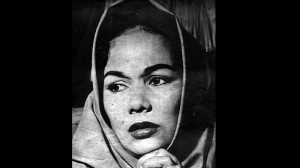
RODRIGUEZ. With her sensitive face, she didn’t have to say a word to tell you what she was thinking.
Lolita Marquez Clark, daughter of an American, William Charles Clark, and a Filipino mother, Carmen Marquez, first appeared in a Sampaguita film, “Ang Ating Pag-ibig,” starring Tita Duran and Pancho Magalona when she was only 18 years old. (She started as a background “extra” in 1953.)
The film was directed by Eddie Romero, who was using the pseudonym, Enrique Moreno. A second movie, “Sa Isang Sulyap Mo, Tita,” became a box-office hit. It was a musical, in which a new comedian who could dance very well, Dolphy, was introduced as the sidekick of Pancho.
Title role
But, Lolita’s appearance in the movie didn’t create any stir. It was in another film made that same year, “Cofradia,” starring Gloria Romero, where Doc Perez took notice of her. Forthwith, he asked the assistant director, Pepe Salameda, to contact Lolita for an interview and was surprised to find out that she had been appearing regularly as an “extra” in the films the studio was making.
Thus, in 1954, Doc Perez changed Lolita’s status—from extra to a cameo role in “Tres Musketeras,” then to “introducing” in “Pilya,” a Gloria Romero-Ric Rodrigo starrer directed by Tony Cayado. At the same time, her screen name was changed to Lolita Rodriguez.
When the only female action star in Sampaguita, Alicia Vergel, was incapacitated by an accident, Doc Perez saw the need to develop another female actioner.
When the idea was broached to Lolita, she was all for enrolling at Feati Tech University, so she would learn such “unfeminine” tasks as trouble-shooting a stalled motor vehicle.
By the time she reported back to Sampaguita for her first starring role in Mars Ravelo’s Tagalog Klasiks serial, “Jack and Jill,” she was ready to play the gay Dolphy’s tomboyish sister, who drove the family’s jeepney in order to make a living. She would find an ally in Rogelio dela Rosa when it came to love matters. It was directed by Mar S. Torres.
Treat
“Jack and Jill” wasn’t only a big hit at the box office in the ’50s, it has also become an all-time movie treat for those who remember Sampaguita’s halcyon days.
Another such movie is Armando Garces’ “Gilda,” where Lolita’s dramatic performance won her the Famas for Best Actress in 1956.
When her 12-year contract with Sampaguita Pictures ended, Lolita tried another genre, the theater. In 1969, she appeared as Candida in “Larawan,” and 10 years later, she reprised the role of Paula.
In her 1958 article, “I Saw Them Grow Up,” in Sampaguita Silver Screen magazine, Rosa Mia described Rodriguez as “a little too chubby and dark,” when she first knew her as an extra.
“But, even as an extra, Lolita struck me as a typical Filipina beauty. And, talk to her, and you knew she was a fine actress. With her sensitive face, she didn’t have to say a word to tell you what she was thinking.
Very close
“In the beginning, she wasn’t popular with the studio folk and the press. She was aloof and hid in a shell.” Eventually, however, Lolita and Rosa became close, and Doc Perez chose the latter to direct the only film that pitted Lolita against Carmen Rosales—1961’s “Octavia.”
After Sampaguita, she continued her work in cinema whenever a good role beckoned. At the 1968 Manila Film Festival, she was the Best Actress awardee for “Kasalanan Kaya?,” and also at the 1971 Catholic Mass Media Awards for “Stardoom.”
But, the film that seems to be her most enduring achievement was Lino Brocka’s 1974 drama, “Tinimbang Ka Nguni’t Kulang.”

